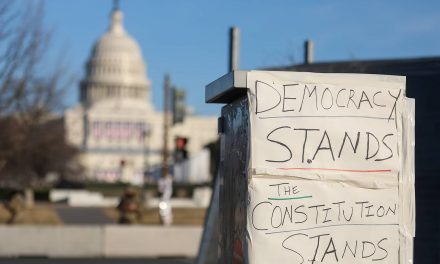
Politico reported that the Supreme Court has already voted to strike down Roe v Wade and Planned Parenthood v Casey, and possibly even Griswold v Connecticut. The decision is in draft form, but expected to be released this summer.
The GOP first set this as a goal in 1981 with the election of Ronald Reagan who, prior to cutting a cynical deal with Jerry Falwell for church help in the 1980 election, had signed the most liberal abortion law in the nation as California governor. Now it appears their 41-year campaign has reached its fruition.
This is the first time in the lifetime of anybody living today that the Supreme Court has removed from our law a major “right” that directly or indirectly affects all Americans.
It is an opinion that does not provide for exceptions for women or children who’ve been raped or are the victims of incest; for women whose age – young or older -puts them at high risk of death from childbirth; or even for a woman with comorbidities that usually rule out pregnancy.
It is, after all, 14 times more deadly for a woman to give birth than to get an abortion, and that’s for “normal” childbearing age women in good health.
By the time this decision is released we’ll have 24 states with so-called “trigger laws” in place that immediately ban abortion – and, in some cases, abortifacient drugs and morning-after pills – the minute the decision is announced.
America, within a few months, will almost certainly be a very different country from the one you lived in during the past 49 years unless Congress — while Democrats still control it — takes action.
That action can take one of two forms, both of which will require bypassing the filibuster – which Democrats today have the power to do; they just must find the will.
Pass a Law
The first strategy is for Congress to pass a law that puts the essence of Roe and Casey into law. This is the most straightforward path, and is what this decision by Alito specifically argues is the only way to protect abortion rights.
It can be done — if Democrats can waive the filibuster — in the next two months before this decision is finally handed down. After all, the Supreme Court isn’t supposed to make law: that’s the job of Congress. And Democrats today control Congress.
The weakness with this path is that when Republicans seize control of Congress and the White House, perhaps as early as 2024, they can simply reverse the Democrats’ abortion-protecting law.
The other weakness of this strategy is that it doesn’t address the overall direction this new Alito decision is moving the Court. If Roe and Casey are gone, probably the Griswold protection for birth control rights and the Obgerfell protection for gay marriage are next.
Packing the Court
The second path is to reshape the Court itself, which could not only re-protect abortion rights but also protect birth control, gay marriage, and again make the court a champion for workers’ and environmental rights.
It’s correct to call it “unpacking,” “rebalancing,” or “expanding” the Court, but no matter how carefully we try to message it, both the GOP and the media will call it “packing the Court.”
And there’s plenty of precedent for that process, although it would also require temporarily setting aside the filibuster.
Packing the Court in 1801:
Thomas Jefferson beat John Adams in the election of 1800, and so, during the lame-duck session of 1801, Adams’ Federalists – the conservative party at that time – passed the Judiciary Act of 1801 to cut the size of the Supreme Court from six members to five, purely to deny Jefferson an opportunity to make an appointment.
Jefferson’s Democratic-Republicans – today’s Democratic Party – reversed that in Congress and increased the number of members of the court to seven in 1802.
Packing the Court in 1866/1869:
In 1866, Republicans in the House and Senate passed a law to reduce the number of justices on the Supreme Court from ten to seven to deny Democratic President Andrew Johnson an opportunity to fill a seat opened up with the 1865 death of Associate Justice John Catron. Johnson was furious, but there was nothing he could do as Republicans held Congress.
Three years later, with Johnson out of the White House and Republican President Ulysses Grant safely in charge, they passed the Judiciary Act of 1869 that raised the number of justices up to nine, where it has stood till today.
Packing the Court in 1937:
During FDR’s presidency, four of the Supreme Court’s justices, Pierce Butler, James Clark McReynolds, George Sutherland, and Willis Van Devanter, were collectively known as the Four Horsemen. They were invariably joined by one of the other justices, particularly Justice Owen Roberts, to strike down New Deal legislation that attempted to address unemployment and poverty, no matter how popular it was.
For the preceding decades during the Lochner era, the Court had struck down dozens of state laws protecting workers, including women and children. In 1935, the Supreme Court ruled that both the Agricultural Adjustment Act and the National Industrial Recovery Act were unconstitutional, gutting Roosevelt’s New Deal legislation.
The Agricultural Adjustment Act had passed in 1933 with 76 percent of the House of Representatives voting for it. The bill passed the Senate, also with 76 percent of the Senate voting for it.
Historian William Leuchtenburg wrote for Smithsonian magazine that after the Agricultural Adjustment Act was struck down, “Many farmers were incensed. On the night following [Justice Owen] Roberts’ opinion, a passerby in Ames, Iowa, discovered life-size effigies of the six majority opinion justices hanged by the side of a road.”
The National Industrial Recovery Act had likewise passed with 71 percent of the House voting for it and 81 percent of senators voting for it.
When the Supreme Court used its power of judicial review to overturn these laws, it wasn’t viewed just as an assault on FDR’s New Deal. It was, in the opinion of many Americans (and FDR himself), an assault on the very basis of our democratic republic.
Then, shortly before Roosevelt was reelected in 1936, the court struck down a New York state law that established a minimum wage for women and children in Morehead v. New York ex rel. Tipaldo.
And as historian David B. Woolner, author of The Last 100 Days: FDR at War and at Peace, noted, “Over… 13 months, the court struck down more pieces of legislation than at any other time in U.S. history.”
In 1937, the National Labor Relations Act and the Social Security Act (both passed in 1935) were on their way to the Court. Considering how the Four Horsemen had ruled during FDR’s first term, Roosevelt knew that he needed to do something or risk losing both pieces of legislation.
With the New Deal on the line, Roosevelt went on the attack. On February 5, 1937, just months after his landslide reelection, he announced his plan. He asked Congress for the authority to appoint one justice for each justice over 70 who would not retire.
Roosevelt’s plan would have immediately given him six appointments to the Supreme Court and up to 44 appointments for federal lower courts. Roosevelt argued that “[a] constant and systematic addition of younger blood will vitalize the courts.”
On March 9, 1937, Roosevelt told the nation that the court was ruling not just against himself and Congress, but against the will of the American people.
“The Courts,” Roosevelt told the nation, “have cast doubts on the ability of the elected Congress to protect us against catastrophe by meeting squarely our modern social and economic conditions.”
Roosevelt’s critics were aghast at his plans. They claimed he was trying the “pack the court” with justices who would simply be his yes men.
Reacting to his critics, Roosevelt cut to the heart of the matter:
“[I]f by that phrase the charge is made… that I will appoint Justices who will not undertake to override the judgment of the Congress on legislative policy, that I will appoint Justices who will act as Justices and not as legislators—if the appointment of such Justices can be called ‘packing the Courts,’ then I say that I and with me the vast majority of the American people favor doing just that thing — now.”
Congress never voted on the plan. It’s unclear whether it would have succeeded, or if a more moderate plan that would have given him only two or three justices might have passed more easily.
Instead, on March 29, 1937, a Washington state minimum-wage law came before the Supreme Court in West Coast Hotel Co. v. Parrish. The law in question was nearly identical to the New York state law that had come before the court a year earlier when it had outlawed minimum-wage laws as being unconstitutional.
But this time, Justice Owen Roberts abandoned the Four Horsemen to uphold Washington’s minimum wage in a 5-4 decision. In a further series of 5-4 decisions two weeks later, the court upheld the National Labor Relations Act as constitutional.
The nation was astonished. Less than two months later, the court declared that Social Security was constitutional.
The New Deal had been saved from execution on the Supreme Court’s bench by bending to Roosevelt’s threat. Social Security had been salvaged, and the National Labor Relations Act gave labor and unions a lifeline after generations of fighting to stay afloat.
Roberts’ about-face in the West Coast Hotel case was referred to at the time as “the switch in time that saved nine,” rendering FDR’s proposal unnecessary.
It is time to play hardball.
Democrats have a short moment here to use historical precedent to reconfigure our government so it represents the will of a majority of Americans. Abortion can be re-legalized if Democrats in Congress choose to set aside the filibuster and either pass a law codifying Roe or, with a more long-term strategy, add new members to the the Court. Or both.
© Thom Hartmann, used with permission. Originally published on The Hartmann Report as Federal Abortion Ban: “Court Packing” Should Be Back on the Table!
Subscribe to The Hartmann Report directly and read the latest views about U.S politics and other fascinating subjects seven days a week.














